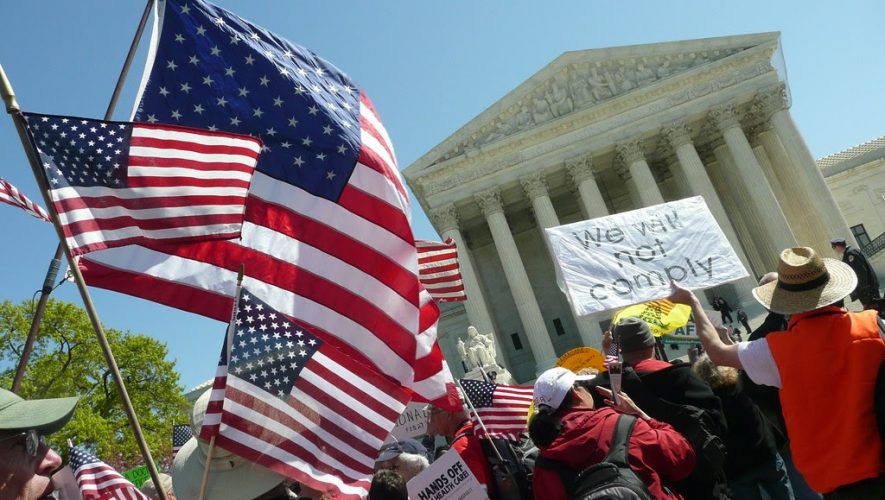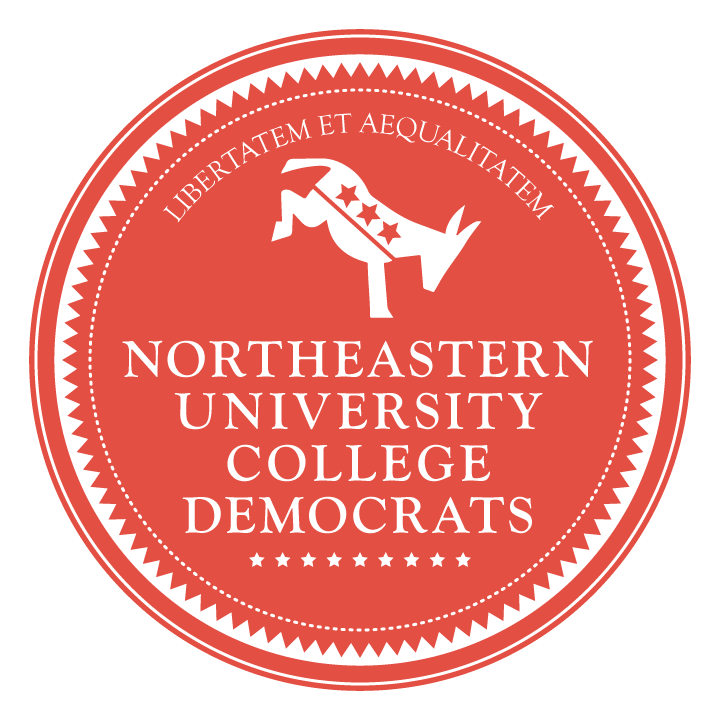This article is one half of a discussion on originalism in American jurisprudence. For its companion, which argues that originalism is a cover for conservative judges to impose their policy preferences, click here.
Justice Amy Coney Barrett’s nomination to the Supreme Court revived political conflict surrounding the judiciary’s proper role in American democracy. The political Left generally sees the Constitution as a “living document” whose meaning can be ascertained through its underlying principles and contemporary application. The Right traditionally counters with an “enduring constitution,” best interpreted through its text, its writers’ intent, and its historical context.
The judiciary’s role as a nonpartisan arbiter of constitutionality is essential to preserve our government’s federalist ideals and system of checks and balances; a “living constitution” that justifies court-driven policy undermines these principles.
The Role of a Judge
Federalism—the division of power between the federal and state governments—is enshrined in our Constitution. The text expressly assigns the federal government’s capabilities. State governments rule over all other matters, provided that the Constitution does not prohibit them from doing so.
The Founders feared factions, or political parties, immensely. They understood that social denominations harbor diverse interests and that these interests sometimes conflict. Thus, they established a federalist system to prevent majority interests from oppressing minorities on a national scale. The Founders also created checks and balances to address this concern; each branch of government limits the power of the others, preventing any one body from gaining too much power.
The judiciary is no exception. In the words of Alexander Hamilton, the courts act as the “bulwarks of a limited Constitution against legislative encroachments” by mandating “all acts contrary to the manifest tenor of the Constitution void.” Hamilton further posited that the judicial branch “will always be the least dangerous to the political rights of the Constitution.” He noted that the courts—limited to judgment—cannot force their will onto the country. As such, courts exist to check legislative power, not to enforce laws. That responsibility falls on the president.
Judicial judgment is also known as jurisprudence, or one’s philosophy of law. There generally exists two categories of jurisprudence: judicial restraint and judicial activism. Judicial restraint aims to honor the judiciary’s original purpose by encouraging the legislative and executive branches—which are accountable to the people—to enact policies. This philosophy interprets the Constitution according to its text, its writers’ intent, and its historical context. On the other hand, judicial activism states that courts should take an active role in solving societal problems, and that judges should interpret the document in accordance with societal changes.
Judicial activists—attempting to improve society through their rulings—imbue the Constitution or statute with novel meanings that justify preferred ideological outcomes. Their rulings render the Constitution meaningless—its interpretation left to the whims of sitting judges. Most often, judicial activists stretch statute, executive orders, and constitutional provisions to account for unpredictable modern developments, or they interpret independent constitutional clauses in tandem to derive new rights.
Justice Antonin Scalia noted that judicial activism had led the Court on a “quixotic quest to right all wrongs and repair all imperfections through the Constitution.” This is evident in cases like Griswold v. Connecticut, where activist justices invented a constitutional “right to privacy” so states could not bar married couples from using contraceptives. In Obergefell v. Hodges, activists justified expanding the Fourteenth Amendment’s original meaning to include same-sex marriage because the “generations that wrote and ratified the Bill of Rights and the Fourteenth Amendment did not presume to know the extent of freedom in all of its dimensions.” In Bostock v. Clayton County, they expanded discrimination on the basis of sex to include sexual orientation. In each of these cases, the judiciary adopted the role of the legislature, modifying existing law to reach a particular outcome.
Such decisions compromise American democracy, threatening federalism and checks and balances. If unelected judges expand and contract constitutional law at will, democracy trends toward oligarchy. Judicial activism forces states to adopt policies that the public may not have sufficiently debated—including some that Americans may resent—breeding political tension and nationwide division. At the same time, judicial activists are so lenient in their interpretations that they resemble legislators more than they do judges.
Alternatively, judicial restraint predicates its scientific-like method of constitutional interpretation on the intended role of the judiciary. Also known as textual-originalism (or just originalism) judicial restraint advises judges that the Constitution’s meaning is static. As a result, a textualist-originalist’s ruling upholds democracy by yielding decision-making to the elected legislature, staying true to the will of the people. In the words of avowed originalist Barrett, “I interpret [the Constitution’s] text as text, and I understand it to have the meaning that it had at the time people ratified it. So that meaning doesn’t change over time and it’s not up to me to update it or infuse my own policy views into it.”
In most cases, originalists have no problem overturning precedents that contradict the Founders’ intent. Although originalists often debate the validity of super precedents—those so entrenched in American life that their alignment with the Constitution is irrelevant—disagreements over which precedents to respect in this way are governed by the most objective legal standard possible.
Getting Loose With Language
Linguistics reveals the ease with which judicial activists can alter constitutional law to fit their political preferences. In the 1700s, the words “awful,” “artificial,” and “amusing” meant “awe-inspiring,” “highly artistic,” and “thought-provoking,” respectively. An uninformed, modern reading of older text with these words would yield an entirely false perception of the passage that contains them.
This shift means that constitutional interpretations based on contemporary meaning can misrepresent the Founders’ intent. For instance, the Second Amendment states, “[a] well regulated Militia, being necessary to the security of a free State, the right of the people to keep and bear Arms, shall not be infringed.” Some have pointed to the phrase “well regulated Militia” to suggest that the Founding Fathers intended for the government regulation of arm-bearers. However, at the time of the founding, “well regulated” simply meant “well armed,” “well-organized,” or “well-disciplined.” Similarly, “Militia” referred to any able-bodied citizen, not an established military force managed by the government.
Politicizing the Court
To discredit Barrett’s nomination to the Supreme Court, elected Democrats accused her of instilling conservative political values, and advocacy groups cited her originalist appeals-court rulings as evidence.
But Barrett’s rulings demonstrate her commitment to apolitical originalist principles. She defended the dissenting opinion in Obergefell because she believes the majority opinion undermined the role of the Court as a constitutional arbiter, not because of her personal convictions on gay marriage. In dissent, Chief Justice John Roberts argued that because the Constitution does not address marriage, the decision is beyond the Court’s purview.
Barrett also disagreed that Title IX protections should extend to transgender people through the court. She did not speak on whether transgender people should be protected; she only argued that Congress did not write Title IX to protect transgender people, which is true. Barrett believes advocates should seek transgender rights through elected representatives, not appointed judges.
Some progressives also claim that Barrett’s ruling on Smith v. Illinois Department of Transportation illustrates her willingness to dismiss racism, but this mischaracterizes her decision. The plantiff alleged that his work environment was hostile, but he could not prove that he endured discrimination on the basis of race, color, religion, sex, or national origin—a requirement for this kind of Title VII claim. In fact, Smith acknowledged that his employer was not discriminatory in his profanity.
One of Smith’s supervisors used the n-word; however, the court determined that Smith failed to prove that this incident made the department’s work environment more hostile since Smith had already been terminated when it occurred. As a result, Barrett joined two other judges in ruling that Title VII did not apply to his case, meaning the Illinois Department of Transportation could not be delineated as a hostile work environment for Black men. Barrett’s adherence to law is not an endorsement of harassment but rather a commitment to impartial judgement.
Barrett is an originalist justice, not a conservative judicial activist. In her role, Barrett will vote on principle, not on her personal views. While there are valid reasons for Democrats to have opposed Barrett’s appointment—as Republicans arguably backtracked on the precedent they set in 2016—her originalist jurisprudence is not one of them. Those who oppose Barrett solely because of her judicial philosophy illustrate an unwillingness to embrace courts that function as they should.
The more general claim that the Republican agenda corrupts originalist judges is similarly unfounded. Recent Republican-appointed originalist Supreme Court justices vote together less often than liberal justices, indicating they are less likely to make decisions that align with their appointing party’s agenda. In the 2018–19 session, the four Democratic appointees voted together 76 percent of the time. In contrast, the five justices nominated by Republicans voted together in just 55 percent of cases. During that term, each conservative justice joined the liberal bloc in deciding a vote at least once.
Other evidence points to the same conclusion. By the “originalism is a trojan horse” theory, far-right activists should be content with originalism since it ostensibly supports their policy goals. Yet, some on the authoritarian right have proposed “Common Good Constitutionalism”—courts imposing a supposedly objective morality—as an alternative, precisely because originalism has outlived its utility for legal conservatives.
Originalists expect to back judicial decisions with outcomes they object to, whether that be morally or politically. They understand that their task is to uphold the Constitution’s meaning, regardless of the political and policy fallout. In contrast, activists use interpretive principles to conjure desired case outcomes.
Consequences of Judicial Activism
It isn’t surprising that interpretive jurisprudence has led to morally abhorrent and constitutionally slanderous decisions considering that justices are shaped by the zeitgeist of their time. Misguided Supreme Court justices intervened in the Dred Scott v. Sanford decision to uphold what they believed was the correct answer to a social issue. The majority disregarded originalist theory to argue that Congress’s 1820 abolition of slavery in northern Louisiana territories was unconstitutional.
Writing for the majority, Chief Justice Roger Taney contended that Congress could determine citizenship standards for foreign- and native-born people. This stretching of “naturalization” to deny native-born Black residents citizenship represents a misguided activist ruling. As dissenting justice Benjamin Curtis pointed out, the Constitution only allows Congress to restrict citizenship for foreigners. Curtis articulates a strong defense of originalism: when justices fail to strictly interpret the Constitution “and the theoretical opinions of individuals are allowed to control its meaning, we have no longer a Constitution.”
In Korematsu v. United States, the majority upheld the executive internment of Japanese Americans without a trial, blatantly rejecting their constitutional right to due process and equal protection under the law. According to one dissent, this conclusion set a dangerous precedent of rationalizing the Constitution to validate “the principle of racial discrimination in criminal procedure and of transplanting American citizens.”
In these cases, justices interpreted an ever-evolving Constitution and took the necessary steps to uphold what they believed to be a vital policy. When courts bend the law in the name of political expediency, there is no guarantee that the pendulum will swing in your favor; in fact, the only thing that it guarantees is that one day it will not.
Judicial activism is partly responsible for the wave of polarization that has plagued America. Between 1994 and 2017, both parties moved sharply toward their ideological extremes. The partisan gap in presidential approval is the largest ever recorded by Gallup for a president. In Congress, Republicans and Democrats cross the aisle less frequently today than ever before, and their constituents have followed suit on a bevy of issues, including Barrett’s nomination.
Activist decisions such as Roe v. Wade—that rely on individual rights not granted by the Constitution—undermine state sovereignty, leading to conservative backlash that spurs liberals to respond. The Supreme Court established a right to abortion when neither it nor the broad privacy right it was based on can be found in the Constitution. It should have been left up to the legislature to extend this liberty.
Judicial activism runs counter to the most crucial principles underlying American government. It imposes the policy preferences of a few justices on a nation of 330 million people, substituting their desires with those of effective oligarchs. It justifies the judiciary’s adoption of legislative powers, threatening the delicate balance of government powers. It fosters political tension, splitting the nation by its most divisive moral controversies. Hamilton noted that “liberty can have nothing to fear from the judiciary alone, but would have everything to fear from its union with either of the other departments.”
Is Originalism Possible?
Critics of originalism also charge that judges cannot translate philosophy into action. Duke University professor Jedediah Purdy characterizes originalism as an “impossible ideal.” For Purdy and others, it is unrealistic for judges to separate politics from their jurisprudence; biases will seep into their decisions, influencing their historical sourcing and reading of language. These critics point out that espoused originalists have—in many cases—failed to justify their vote with the Constitution.
These critics neglect nuance. Originalism is not perfect, but it is the better of two imperfect judicial philosophies. Activism embraces legislating from the bench to achieve policy goals. Originalism doesn’t promise policymaking can’t happen; it merely seeks to limit such power abuse as much as possible. In the former, violation of a judge’s judiciary responsibility is endemic. In the latter, violations occur less frequently and more moderately.
By deferring to the Constitution as often as possible—reducing case decisions to a debate of historical text, intent, and context—there is constraint in the law’s ambiguities, and judicial overreach is less likely. Justice Scalia pointed this out in his writings, positing that originalism creates “something of a compromise” when factoring in the influence of biases on historiography.
There are also many cases in which originalist federal judges haven’t ruled the way their appointer’s politics would have predicted. Cherry-picking cases that deviate from originalism says nothing about the merits of originalist philosophy as properly practiced, nor does it dispute Scalia’s contention that originalism trends toward compromise and moderation.
Originalism is an imperfect science. It is a methodology that converges on the purpose of laws through an insistence that the Constitution’s original meaning should limit judicial decisions. Among originalists, there is lively debate concerning the Constitution’s meaning, intent, and context, but among activists, there is a political agenda to pursue.
Originalism in Action
While judicial restraint is often erroneously portrayed as an impediment to social progress, it can and has supported leftist agendas, struck down regressive legislation, and changed the direction of American democracy, all while following the Constitution’s written mandate and intent.
In Texas v. Johnson, Republican-appointed Scalia wrote for the majority, upholding flag burning as expression protected by The First Amendment, a traditionally liberal position. The majority ruled according to originalist principals, declaring that the government “may not prohibit the expression of an idea simply because society finds the idea itself offensive or disagreeable.”
The landmark Supreme Court case Brown v. Board of Education—in which the justices unanimously ruled that school segregation violated the Fourteenth Amendment’s Equal Protection Clause—is another prime example of how originalism can result in dramatic progress.
Following the Fourteenth Amendment’s ratification in 1868, congressional discourse clarified its intended purpose. School segregation became a dominant political issue and Congress passed the Civil Rights Act of 1875 in the hopes of guaranteeing equal access to public accommodations, including schools.
The act clarified and contextualized the amendment’s definition of equal protection. The congressional majority’s explicit support for integration suggests that the most accurate constitutional interpretation of the Fourteenth Amendment is one that also supports integration. In Brown, the Supreme Court ruled accordingly. Brown was necessary only because the 1875 law was quickly struck down on unrelated Tenth Amendment grounds.
Judicial activism supporters often claim that originalists do not support pivotal decisions like Brown, but this claim overlooks the substantial historical climate that contextualizes the Fourteenth Amendment. Since the landmark decision, originalists have supported and upheld the precedent, whether that be Justices Scalia or Thomas or legal scholars.
The beauty of originalism is that policy outcomes are not set in stone. All Americans benefit from courts upholding the Constitution rather than the policy preferences of unelected judges.
A Bulwark Against Tyranny
Some characterize originalism as a “fancy word for discrimination,” ignoring that originalists believe public discrimination to be unconstitutional. The Fifth and Fourteenth Amendments are explicit: no state may deny any person of “life, liberty, or property” without due process and equal application of the law. If originalists oppose state-sanctioned discrimination, they cannot favor discrimination generally.
Originalism does not justify federal- or state-enforced discrimination. Judicial activism is the true threat to equality. It expands federal power beyond its jurisdiction and merges legislative and judicial authority, spurring political division and undermining the will of the people.
Without originalist jurisprudence, Americans are at the mercy of unelected, incontestable judges. It is essential, for the sake of our democracy and the future of the United States, that we hold the Supreme Court to its intended mission: arbiting, not making, policy.



